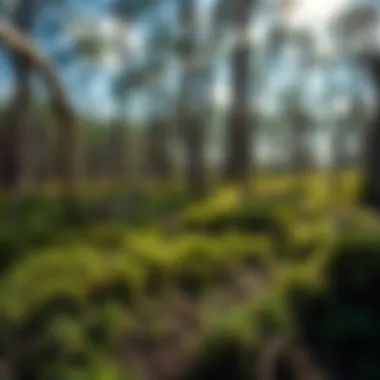Strategies for Effective Leafy Spurge Management


Intro
Leafy spurge (Euphorbia esula) stands as a formidable foe in the realm of invasive species, impacting ecosystems and agricultural lands alike. Its rapid growth and ability to occupy vast territories make it a significant worry for landowners and forestry professionals. This article aims to explore effective strategies to manage leafy spurge infestations through a combination of practical approaches that align with sound ecological principles. As we dissect various strategies, from mechanical methods to biological control, we hope to shed light on the relevance of these practices for managing this invasive species.
Overview of Forestry Practices
Importance of Foresting
Forests are not just collections of trees; they are complex ecosystems serving as crucial habitats for countless species. They play a vital role in regulating the climate, conserving water, and fostering biodiversity. The challenges posed by invasives like leafy spurge can adversely affect these ecosystems, highlighting the importance of effective forestry management. An understanding of forestry practices helps in restoring balance within these environments, reducing the invasiveness of species that threaten native flora and fauna.
Types of Forestry Practices
Forestry practices can be categorized into various approaches, each tailored to address specific ecological and management goals:
- Silviculture: This involves the management of forest growth and harvesting, focusing on sustaining forest health while meeting wood product demands.
- Agroforestry: Combining agriculture and forestry, agroforestry aligns agricultural practices with tree planting to enhance productivity and biodiversity.
- Reforestation: Essential for restoring ecosystems, reforestation reintroduces native species into areas affected by deforestation or invasive species.
These practices are core to sustaining forest ecosystems and combating challenges posed by invasive weeds.
Best Practices for Sustainable Woodland Stewardship
Principles of Sustainable Forestry
A key tenet of sustainable forestry involves maintaining ecological balance while fulfilling human needs. This includes:
- Conservation: Preserving native species and habitats.
- Resilience: Implementing methods that allow forests to withstand environmental changes.
- Community engagement: Involving local stakeholders in management decisions fosters a shared sense of responsibility and ensures diverse perspectives are considered.
Techniques for Land Management
Crafting effective land management strategies is central to combating leafy spurge infestations. Consider a mix of the following techniques:
- Mechanical removal: Cutting or mowing leafy spurge can reduce its spread, but it must be done repeatedly to prevent regrowth.
- Chemical treatments: Herbicides like glyphosate need to be used cautiously to minimize ecological disruption while effectively targeting leafy spurge.
- Biological control: Introducing natural predators, such as certain beetles that specifically target leafy spurge, can help to naturally manage its population.
These techniques, when applied with careful consideration, can significantly mitigate the impact of leafy spurge on woodland areas.
Innovative Techniques in Forestry
Latest Technological Advancements
The forestry sector has welcomed numerous advancements that bolster management efforts against invasive species. Geographic Information System (GIS) tools enable practitioners to map infestations accurately and plan interventions intelligently. Drone technology can also facilitate monitoring and assessment, providing insights that are hard to gain from traditional ground surveys.
Integrating Traditional Knowledge with Modern Science
A holistic approach that fuses traditional land management practices with contemporary scientific research often yields the best results. Indigenous knowledge, passed through generations, can offer practical insights into natural pest management and sustainable practices that have stood the test of time.
"Bridging the gap between age-old wisdom and cutting-edge science fosters a resilient and adaptive approach to forestry management."
Preamble to Leafy Spurge
Managing leafy spurge is not just a simple task of pulling a weed here and there. This invasive plant is a formidable opponent in the battle for health and productivity in both natural ecosystems and agricultural lands. Understanding leafy spurge is crucial because it helps landowners and professionals develop effective strategies for control and management, ensuring the preservation of native species and agricultural integrity.
Nature and Characteristics
Leafy spurge, scientifically known as Euphorbia esula, is a perennial plant characterized by its milky sap, which can irritate the skin. Its growth habit allows it to thrive in a variety of conditions. Standing between 12 to 36 inches tall, its stems are erect, and its leaves are lance-shaped and alternate in arrangement. During late spring to early summer, the plant produces small, greenish-yellow flowers that can easily be overlooked. Beyond its outward appearance, leafy spurge possesses a robust root system that can extend deep into the soil, making eradication a real challenge. This characteristic not only aids its survival but allows it to outcompete many native plant species for resources such as light, water, and soil nutrients.
Given its tenacity, it’s important for managers and landowners to recognize that simply attempting to cut it back won’t yield long-term results. Instead, a comprehensive understanding of its biology and growth patterns is essential.
Geographic Distribution
Leafy spurge has made a name for itself as a widespread offender across North America and parts of Europe. It’s particularly prominent in the northern Great Plains, where it has become a dominant species in disturbed areas, fields, and pastures. Local ecosystems, once rich with diverse plant life, can quickly become dominated by leafy spurge. Its presence is often marked in the following regions:
- Montana: Known for its grasslands, leafy spurge has encroached upon vast areas, making native grazing areas less viable for livestock.
- North Dakota: A substantial problem in rangelands, where it expands rapidly and diminishes biodiversity.
- Minnesota: Found in numerous locations across the state, leafy spurge poses threats to natural habitats.
Leafy spurge can take hold in both dry and wet soils, allowing it to exploit a variety of environments. Consequently, landowners need to be on high alert for its presence and be prepared for proactive management if they wish to protect their land from this aggressive invader. Through detailed understanding of its behaviors and habitats, this article aims to equip readers with effective strategies to tackle this pervasive plant.
The Ecological Impact of Leafy Spurge
The ecological impact of leafy spurge is a topic that cannot be swept under the rug. This pesky plant does not just take up space; it aggressively replaces native vegetation, which can lead to cascading effects throughout local ecosystems. By understanding the ecological ramifications, we can better strategize our control efforts, making them not just reactive, but proactive. This section delves into how leafy spurge interferes with biodiversity and alters soil compositions, demonstrating its extensive effects on the environment.
Biodiversity Effects
Leafy spurge’s ability to overrun natural habitats is at the core of its negative ecological footprint. When this plant establishes itself, it often forms dense stands that leave little room for native species to thrive. This monoculture effect can decimate biodiversity in various ways:
- Competition for Resources: Leafy spurge efficiently hogs water and nutrients, making it difficult for neighboring plants to survive. In many cases, native species either slowly decline or completely vanish from the landscape, leading to a barren ecological scenario.
- Habitat Loss: As the spurge takes control, it transforms the habitat. Local fauna that depend on native flora for food and shelter find themselves in a precarious situation. The absence of diverse plant life disrupts the entire food web, affecting herbivores, predators, and various other organisms.
- Altered Ecosystem Functions: Healthy ecosystems perform several functions like pollination, seed dispersal, and nutrient cycling. When diversity dwindles, these functions can break down, leading to a less resilient ecosystem. Essentially, when leafy spurge comes in like a wrecking ball, it sends the ecosystem into disarray.


"A diverse ecosystem isn’t just pretty to look at; it’s crucial for sustainability. Losing it not only changes the landscape but also the health of the ecosystem itself."
Soil and Nutrients
Soil health is another critical area impacted by leafy spurge invasion. As this weed proliferates, it alters not just the surface but also the below-ground ecosystem, which can have long-lasting repercussions:
- Soil Composition: Leafy spurge can change the nutrient composition of the soil. Some studies indicate that spurge can increase nitrogen levels, which might initially seem beneficial. However, when native plants do not adapt to this new nutrient profile, it becomes a double-edged sword that favors the invasive spurge even more.
- Soil Erosion: Unlike native plants with extensive root systems that stabilize the soil, leafy spurge's root structure does not provide the same benefits. As a result, areas dominated by spurge may become more susceptible to erosion, especially during heavy rains or high winds. This loss can lead to the degradation of arable land and contribute to sedimentation in nearby waterways.
- Microbial Activity: The presence of leafy spurge can affect soil microbial communities. When the microbial population shifts in response to increased nitrogen and other nutrients, it can disrupt the nutrient cycling essential for plant growth. This can result in a vicious cycle, further promoting the growth of leafy spurge at the expense of other plants.
In summary, the ecological effects of leafy spurge extend far beyond the visible reductions in biodiversity. Its ability to alter soil composition and affect nutrient cycles deepens the concern for long-term impacts on ecosystems harboring this invasive species. Managing these effects is crucial to restoring equilibrium and fostering healthier ecological landscapes.
Identifying Leafy Spurge
Understanding how to identify leafy spurge is a critical first step in effective management. Distinguishing this invasive plant from native vegetation can significantly save time and resources in controlling its spread. The quicker one recognizes the characteristics of leafy spurge, the sooner action can be taken to prevent infestation from spiraling out of control. This skill is particularly valuable for forestry professionals and landowners alike, ensuring that the right management strategies are applied effectively.
Visual Characteristics
Leafy spurge, scientifically known as Euphorbia esula, stands out for its unique physical traits. At first glance, this perennial plant can reach heights of 1 to 3 feet and has a somewhat upright growth habit. The leaves are narrow, lance-shaped, and alternate, creating a bushy appearance. In the spring, the plant produces small greenish flowers that are often overlooked, but they are a tell-tale sign of its presence. During peak flowering, these can turn a pale yellow-green.
An important aspect to note is its milky sap, which seeps from broken stems. This sap can cause skin irritation; therefore, handling leafy spurge should be approached with caution. It's also worthwhile to familiarize oneself with its seed capsules, which can be easily mistaken for those of other plants but contain small, brown seeds that are capable of spreading easily. Being aware of these markers is essential for effective identification.
"Correct identification paves the way for timely intervention, preventing leafy spurge from claiming large swathes of land."
Seasonal Changes
Leafy spurge goes through notable changes throughout the seasons, and awareness of these transitions can aid in its identification. In the spring months, the plant sprouts rapidly, showcasing vibrant green foliage that can resemble other native species, but its unique flower clusters can clue you in on its identity.
By summer, leafy spurge often forms dense patches, making areas appear unkempt and overtaken by its aggressive growth. Its ability to outcompete native flora becomes apparent as the competition for resources intensifies. Autumn marks the death of many native plants, but leafy spurge often remains green, standing out amongst the withered surroundings. Lastly, in winter, the plant can appear as a dry brown stalk, yet its distinctive growth habit remains recognizable.
Understanding these seasonal markers can enhance one's ability to properly identify leafy spurge at various times of the year, providing vital insight needed for effective management strategies.
For more detailed information, consult resources like USDA Plants or the National Invasive Species Information Center.
Assessment of Infestation
Assessing the infestation of leafy spurge is crucial for landowners and land managers aiming to contain and control this invasive species. Understanding the extent and severity of the invasion can significantly influence the chosen management strategies. An effective assessment leads to informed decision-making, ensuring that the selected methods are both efficient and cost-effective.
Evaluating Severity
Evaluating the severity of leafy spurge infestations involves examining several key elements: density, distribution, and the impact on surrounding flora and fauna. Recognizing the density of leafy spurge can guide management practices. A low-density invasion might just require a few targeted interventions, while a high-density area may necessitate a more aggressive approach.
Factors to Consider in Severity Assessment:
- Plant Density: Count the number of leafy spurge plants in a designated area. This can help categorize the severity from low to high infestation.
- Distribution Pattern: Note whether plants are widespread or localized. A clustered invasion indicates the need for precise control measures, focusing on the epicenter of the problem.
- Impact on Native Species: Assess the effects on beneficial plants in the area. A significant decline in biodiversity signals a severe infestation that warrants immediate attention.
Regular monitoring is critical; being proactive can prevent a minor issue from mushrooming into a major problem. It’s suggested to adopt a routine check every season.
Mapping Infested Areas
Mapping infested areas serves to visualize the spread of leafy spurge on the landscape. Implementing a systematic mapping strategy enhances management plans by clearly indicating high-priority zones for eradication efforts.
Steps to Create an Effective Map:
- Utilize GIS Technology: Geographic Information Systems can help in accurately marking infested regions and tracking changes over time. This tech-savvy approach benefits those with a flair for maps, providing an accurate depiction of the invasion.
- Mobile Applications: There are several user-friendly mobile applications available for field mapping of invasive species. These tools enable immediate updates from the field, making it easier to adapt strategies.
- Collaborate with Local Agencies: Partnering with state or federal agencies can yield updated information and resources. Their expertise can enrich mapping efforts and provide additional data for effective management.
"Effective mapping of leafy spurge infestations can serve not just to identify problems but also to visualize progress in control efforts."
By consistently evaluating the severity of infestations and effectively mapping infested areas, landowners and forestry professionals can develop a comprehensive and adaptable strategy to manage leafy spurge effectively. This foundational step cannot be overstated; without proper assessment, any control efforts could be akin to shooting in the dark.
Further Reading:
- Geographic Information Systems and Invasive Species
- Understanding Plant Density
- Techniques for Mapping Weeds
This assessment lays the groundwork for exploring control methods, ensuring strategies are tailored to the specific conditions and needs of the area.
Control Methods for Leafy Spurge
Managing leafy spurge infestations requires a strategic approach, as this invasive plant can outcompete native flora, leading to biodiversity loss and decreased agricultural productivity. Effective control methods are crucial not only for protecting native ecosystems but also for ensuring the health of agricultural lands. Each method comes with its unique benefits and considerations that must be carefully evaluated to achieve the best results. A combination of techniques often yields the most effective control and helps prevent future outbreaks.
Mechanical Control Techniques
Mechanical control strategies focus on physically removing leafy spurge from the environment. This method can be quite effective, primarily when used in conjunction with other techniques. Common mechanical control practices include:
- Mowing: Regular mowing can help reduce the biomass of leafy spurge, preventing it from flowering and setting seed. However, it's essential to mow often enough to catch the plants before they go to seed. Aim for a height of about six inches; cutting too low might result in stronger regrowth.
- Tilling: Tilling can disrupt the root system of leafy spurge, particularly if done periodically. However, it is important to note that this can also disturb surrounding soil and encourage the growth of other weeds, thus requiring careful management of the site post-tillage.
- Hand Pulling: For smaller infestations, hand pulling may be a viable option. It requires diligence to ensure that the entire root is removed, as any remaining parts can regenerate the plant. This tactic is particularly useful in areas where chemical and broader mechanical methods are inappropriate.
While mechanical methods can be labor-intensive, they minimize chemical reliance and can provide immediate results in managing shy leafy spurge populations. A key consideration here is that these techniques must be applied consistently to ensure effectiveness over time.


Chemical Control Options
Chemical control involves the use of herbicides, which can be a powerful ally in the fight against leafy spurge. While chemical treatments can be highly effective, they also necessitate careful consideration of environmental impact and regulatory compliance. Common herbicides used against leafy spurge include glyphosate and imazapic. Here are some vital points regarding chemical control:
- Timing is Everything: The effectiveness of herbicides often hinges on the timing of application. Herbicides tend to be most effective when applied during the plant's active growth stages, typically in spring before flowering.
- Selective vs. Non-Selective Herbicides: Depending on the situation, either selective or non-selective herbicides may be preferable. Selective herbicides can target leafy spurge while leaving desirable plants unharmed, while non-selective herbicides will kill most vegetation they come in contact with. Knowing when and where to apply these is crucial.
- Resistance Management: Leafy spurge can develop resistance to herbicides, which could render treatments ineffective over time. Alternating between different classes of herbicides can help mitigate this risk.
Tip: Always follow label instructions and adhere to local regulations when using chemical control methods, as improper use can lead to significant environmental disturbances.
Biological Control Strategies
Biological control offers an ecologically friendly avenue for managing leafy spurge populations. This strategy revolves around using natural enemies to suppress the weed's growth. While it may take longer to manifest results compared to mechanical and chemical methods, biological control provides a sustainable, long-term solution. Key biological control methods include:
- Using Insects: Specific insect species, including the leafy spurge flea beetle, have been found effective in reducing leafy spurge populations. These beetles feed on the plant's foliage and can significantly impact its health and reproductive capacity.
- Fungal Pathogens: Certain fungal pathogens can infect and reduce the vigor of leafy spurge. Research into fungal strains that can target this weed is ongoing, with hopes for more effective implementation in the future.
- Grazing: Livestock such as sheep and goats can graze on leafy spurge, which can be part of a larger integrated pest management strategy. Controlled grazing allows for management of the weed while utilizing the land for agricultural production.
Biological control methods tend to integrate better with the environment and produce less harmful side effects than chemical treatments. However, success often requires patience and monitoring, as establishing effective biological controls may take time to fully realize their potential effects.
Best Practices for Long-Term Management
Long-term management of leafy spurge involves more than just a quick fix; it’s about creating a sustainable strategy that preventing future infestations. Current approaches indicate that managing this invasive species is a complex challenge. However, with focused strategies, it is possible to significantly reduce its impact on native ecosystems and agricultural lands.
Integrated Pest Management (IPM)
Integrated Pest Management, or IPM, emphasizes a combination of methods for controlling pests, rather than relying solely on chemical solutions. It involves the following key elements:
- Cultural Practices: Adjust agricultural practices to create less favorable conditions for leafy spurge. This might mean rotating crops, adjusting planting schedules, or implementing cover crops that compete with the weed.
- Biological Control: Utilizing natural enemies, like certain insects or fungi, can prove to be an effective way to manage leafy spurge. Research includes studies on insect species that specifically target the weak points of this plant, contributing to its decline.
- Mechanical Removal: Regularly mowing and tilling fields can physically remove leafy spurge and interrupt its growth cycle. It’s important to time these actions appropriately to maximize their effectiveness, especially before seed production.
- Chemical Options: While integrated management does not exclude chemicals, it recommends their limited use in conjunction with the above methods. Herbicides can be effective, but should be applied carefully and selectively, ensuring they target leafy spurge while sparing desirable vegetation.
Implementing an IPM strategy is a multifaceted approach that requires familiarity with local conditions and the specific challenges they present. Adopting these practices allows landowners to control leafy spurge while minimizing harm to the broader ecosystem.
Monitoring and Adaptation
Monitoring the effectiveness of strategies you've chosen to implement is crucial. This means not only tracking known infestation areas but also observing how changes in conditions affect leafy spurge populations. Take note of:
- Infestation Patterns: Regularly survey the areas previously affected by leafy spurge. Look for new growths, as emerging plants can signal that management methods need adjusting. Keeping meticulous records can assist with future decision-making.
- Effectiveness of Control Methods: Review how well various control methods are performing and modify approaches according to their success rates. For example, if mechanical control doesn't seem effective in a specific area, re-evaluating the timing of the harvest might yield better results.
- Environmental Changes: Factors such as rainfall, temperature, and soil conditions play a role in how leafy spurge grows. Monitoring these can help inform both immediate and long-term strategies. If sudden floods increase infestation rates, developing a plan to address this could could prevent future outbreaks.
- Community Input: Engaging local stakeholders in monitoring efforts can lead to a collective understanding of the issue and collaborative solutions. Knowledge sharing among landowners helps improve management practices across neighboring properties.
By prioritizing monitoring and remaining adaptable, land managers can refine their strategies based on what works best in their specific environments. This vigilance is not only useful for dealing with leafy spurge but also fosters a deeper understanding of how to maintain healthy ecosystems.
"Management is not merely a matter of removing a problem; it’s about adapting with respect to the changing dynamics of your environment."
Through these strategies, practitioners can anticipate and respond to challenges that arise, ensuring that their efforts against leafy spurge are not just temporary solutions but paving the way for lasting ecological health.
Community Involvement and Education
The management of leafy spurge is not solely the duty of landowners or professionals. In fact, community involvement plays a pivotal role in combating this invasive plant. Engaging local communities in the effort to control leafy spurge creates a shared responsibility that amplifies the effectiveness of management strategies. Moreover, this approach nurtures a deeper understanding of ecological impacts and fosters stewardship among residents.
Engaging Local Stakeholders
One of the first steps in galvanizing community action is to identify and engage local stakeholders. This group could comprise:
- Agricultural producers who are directly affected by the spread of leafy spurge.
- Local government entities that manage public lands and regulations.
- Conservation organizations which actively work toward preserving local ecosystems.
- Educational institutions that can contribute research and volunteerism.
“Success in managing invasive species like leafy spurge relies on collaboration and broad-based support from the community.”
To effectively engage stakeholders, regular community meetings can be organized where individuals can voice their concerns and suggestions. Furthermore, initiatives such as forming local weed management groups can enhance collaboration. These gatherings also provide an opportunity to disseminate useful information about best practices and emerging technologies in spurge management. In many cases, working together not only bolsters the resources available for combating infestations but also fosters a sense of community ownership.
Awareness Campaigns
Raising awareness is another essential strategy in combatting leafy spurge. Effective awareness campaigns can boost community knowledge about the biological and ecological threats posed by the weed, thus motivating local populations to participate in its management. Crafting compelling messages requires the use of diverse media as well as local engagement. Here are some key components:
- Educational Workshops: Hosting workshops at local schools or community centers to educate residents about identification and management techniques.
- Social Media Outreach: Utilizing platforms such as Facebook or Instagram to share success stories, management tips, and updates on local initiatives.
- Informational Flyers: Distributing flyers in neighborhoods can serve as a physical reminder of the importance of addressing leafy spurge.
Involving community members through hands-on activities, like organized pulling events or planting native species in previously infested areas, can also generate enthusiasm and support. These grassroots efforts not only increase public awareness but also empower individuals to take tangible steps toward managing the challenges posed by this invasive species.
Ultimately, uniting community efforts and educational initiatives paints a clearer picture of how everyone can contribute to meaningful progress in the fight against leafy spurge. By anchoring efforts in collaboration and informed participation, communities can significantly mitigate the impacts of this pervasive weed.
Regulatory Considerations
When tackling leafy spurge infestations, it’s not just about the weeds themselves; understanding the regulatory landscape is crucial. Navigating this often complex set of guidelines helps ensure that management strategies are effective and lawful. Moreover, these regulations often serve the dual purpose of safeguarding the environment while providing structured methods to combat invasive species. Landowners and professionals must grasp the ins and outs of these rules to avoid potential pitfalls and, additionally, to foster collaboration with local communities and agencies.
State and Federal Regulations
Each state has its own unique set of laws concerning the management of invasive species, including leafy spurge. On a broader scale, federal regulations also play a significant role, mainly focusing on environmental protection and safety. For instance:
- State Laws: These may include mandatory reporting of infestations, restrictions on certain herbicides, or requirements for restoration efforts. States like Montana and North Dakota have specific programs aimed at controlling leafy spurge, recognizing its rapid spread and detrimental effects on native ecosystems.
- Federal Guidelines: Under laws such as the Federal Insecticide, Fungicide, and Rodenticide Act (FIFRA), there are stipulations regarding the use of chemical controls. The Environmental Protection Agency (EPA) oversees the registration of herbicides, ensuring they are safe for human health and the environment.
Understanding these regulations can shape better strategies for managing infestations while ensuring compliance. When in doubt, consulting with local agricultural extension services or state departments of natural resources can clarify any ambiguous aspects of the laws.


"Navigating regulations is like walking a tightrope; one misstep can lead to significant consequences."
Permits for Chemical Treatments
Administering chemical treatments to control leafy spurge isn't merely a matter of pulling the trigger on the sprayer. Often, obtaining the appropriate permits is a necessary step. These permits might be required based on the product used, the application rate, or the type of area being treated (like wetlands or near water bodies). Here’s what to keep in mind:
- Application Process: Before using chemicals, it is essential to apply for permits through state or local environmental agencies. This process may include submitting a detailed plan outlining how treatments will be conducted, including safety measures and protective steps for non-target species.
- Documentation: Keep a record of all treatment applications, including dates, weather conditions, and results. Proper documentation not only supports compliance but also aids in future planning and adjustment of strategies.
- Endangered Species Considerations: If a treatment area is home to endangered species, additional scrutiny may apply. Permits can require that certain precautions be taken to protect these species during the treatment process.
By being diligent about permits and following state and federal regulations, landowners and professionals can focus their efforts on effective strategies that truly mitigate the impact of leafy spurge without running afoul of regulatory frameworks. Doing so not only fosters responsible practices but also contributes positively to the larger goal of sustainable land management.
Case Studies of Leafy Spurge Management
In any field, looking at practical examples can illuminate the way forward. The same is true for managing leafy spurge, a stubborn weed that frequently poses challenges for landowners and forestry professionals. Case studies not only provide real-life instances of actions taken but also showcase the effectiveness of various strategies. As such, they can reveal the complexity of dealing with this invasive species, and offer insights into what works best.
One significant benefit of diving into case studies lies in their ability to evaluate the performance of different control methods in specific environments. This is essential as no two situations are identical. The geographic location, soil type, and even weather conditions can dictate what approach might be effective. Understanding these nuances through case studies is vital for any long-term management strategy. Moreover, these examples serve as a springboard for innovation, allowing other stakeholders to tailor techniques to their unique circumstances.
When examining case studies, certain key elements are worth considering:
- Context: Each case context can vary from agricultural lands to natural reserves.
- Methods Used: Some may employ mechanical control, while others use chemicals or biological means.
- Outcomes: Success rates and challenges faced provide crucial learning opportunities.
- Stakeholder Involvement: Engagement with local communities often plays a role in shaping effective strategies.
By looking closely at successful implementations and reflecting on the lessons learned, stakeholders can develop a robust understanding that serves both immediate needs and long-term ecosystem health.
Successful Implementations
A notable case of successful leafy spurge management can be found in the Northwest area of Montana. Here, landowners cooperated with local conservation groups to implement an integrated pest management (IPM) approach. The strategy combined mechanical pulling, targeted herbicide applications, and the introduction of biological control agents like Euphorbias, a type of weevil that specializes in feeding on leafy spurge.
The key factors that led to success in this implementation were:
- Community Collaboration: Local landowners worked together, sharing information and resources, fostering a spirit of shared responsibility.
- Adaptive Management: Ongoing monitoring allowed the team to tweak their strategies based on real-time results. When a particular method didn’t yield the anticipated results, they quickly adjusted course.
- Public Awareness: Community education campaigns made residents aware of the problem and motivated them to engage in pest management.
The outcome was striking. Within three years, the team reported a 50% reduction in leafy spurge coverage in the treated areas.
Lessons Learned
Every success story is accompanied by challenges. From the above case study, several lessons emerge that can inform future efforts:
- Patience is Key: Managing leafy spurge isn't a quick fix. Immediate results are unlikely, and patience is necessary for long-term solutions.
- Flexibility Matters: The environment is ever-changing. Land managers must remain open to adjusting strategies as conditions evolve, such as changes in rainfall or the emergence of new pest species.
- Importance of Follow-Up: A one-off treatment is rarely sufficient. Continuous monitoring and follow-up treatments are essential to prevent resurgence of the weed after initial successes.
Future Directions in Leafy Spurge Research
As we look ahead, exploring future directions in leafy spurge research is not just an academic pursuit but a necessity for preserving native ecosystems and fostering agricultural resilience. One of the key aspects to focus on is understanding how leafy spurge adapts to its environment. Investigating genetic variations and their influences on growth patterns can illuminate why this weed thrives in certain areas while struggling in others. This knowledge is pivotal for developing targeted management practices that are more effective and environmentally sound.
Moreover, in a world increasingly relying on sustainable practices, it’s essential to sharpen our focus on biological control methods that leverage natural predators or diseases that can effectively keep leafy spurge populations in check. Research can shed light on specific insects or microorganisms that could be used as biological control agents, aligning with eco-conscious pest management strategies. Additionally, integrating findings from other invasive species management could lead to the adaptation and application of successful methodologies, thereby fostering innovation.
However, the exploration of these avenues is not without its challenges. Understanding the implications of any new strategies on the ecosystem and potential non-target effects must be a priority. Thus, collaborative efforts among researchers, stakeholders, and land management agencies become crucial.
Innovative Approaches
The landscape of leafy spurge management is shifting, driven by a commitment to innovation. One significant step is the use of genetic engineering as a tool in controlling this invasive species. For instance, scientists are investigating genes that can render leafy spurge less competitive, potentially allowing native plants to reclaim their space without harming the environment with conventional herbicides. This could be a game changer, permitting nuanced control without the collateral damage often seen with chemical treatments.
Moreover, community-based participatory research is gaining momentum. By involving local communities in research endeavors, researchers can gain richer data that reflects specific regional challenges. This not only enhances the relevance of research findings but also empowers communities by giving them a stake in the outcomes, which is vital for long-term management efforts.
Another innovative pathway that is showing promise is the application of machine learning models to predict leafy spurge invasion patterns. Utilizing data from various geographical and climatic data can help in forecasting which areas are at risk and allow for proactive management measures.
Technology in Management
The role of technology in managing leafy spurge cannot be overstated. Remote sensing technology is opening up new horizons for understanding and monitoring infestations. Drones equipped with multispectral cameras can provide aerial imagery to assess the extent of infestations. This data can help land managers make informed decisions about where to allocate resources and which control methods would be the most effective. With the ability to gather precise data over large areas quickly, the efficiency of management efforts is greatly increased.
Another advancement is the use of mobile applications designed for pest management. These applications can offer identification tools for landowners who may not be familiar with leafy spurge, fostering better recognition and thus, quicker responses to fledgling infestations. An example includes apps that allow users to contribute geo-tagged photos, thereby creating a crowd-sourced map of leafy spurge distribution. This type of localized data can be invaluable, not only for immediate management but also for long-term research needs.
"Effective management of invasive species like leafy spurge requires ongoing research, innovative tools, and collaboration among all stakeholders."
For more insights into managing invasive species, check resources from University Cooperative Extensions or the U.S. Department of Agriculture.
Finale
Managing leafy spurge infestations requires a thorough understanding and proactive approach. This conclusion serves as a crucial component in reinforcing the importance of previously discussed strategies and highlighting the need for continual effort in controlling this invasive species. The layered strategies for combating leafy spurge—spanning mechanical, chemical, and biological methods—illustrate just how multifaceted and demanding the management landscape can be. The necessity for agricultural stakeholders and conservationists to remain vigilant cannot be overstated; the success of any management endeavor rests heavily on consistent monitoring and adaptation to evolving challenges.
Summary of Key Points
- Identification: Recognizing leafy spurge is the first essential step. The weed's unique visual characteristics and seasonal changes help distinguish it from other flora.
- Ecological Impact: Leafy spurge's impact on biodiversity and soil health must be considered as it competes aggressively with native species, leading to alterations in the ecosystem.
- Assessment and Mapping: Understanding the severity of infestations and mapping affected areas focus control efforts where they are most needed.
- Control Methods: Utilizing a combination of mechanical, chemical, and biological control techniques provides a more effective strategy. Understanding when and how to apply these measures can significantly affect outcomes.
- Community Involvement: Engagement with local stakeholders and awareness campaigns create a supportive environment for shared responsibility in managing invasive species.
- Regulatory Considerations: Staying informed about federal and state regulations regarding control methods helps practitioners avoid potential legal issues while ensuring compliance.
- Future Directions: Innovation and technology play vital roles in developing new management strategies, highlighting ongoing research importance in adapting practices.
Encouragement for Active Management
Effective management of leafy spurge is not a one-off task but a journey that requires dedication and collaboration. Stakeholders in forestry, agriculture, and conservation must not only take action but also encourage others in their communities to do the same.
The collective effort can open doors to improved practices, leading to healthier ecosystems and more productive landscapes. It's essential to cultivate a mindset that appreciates ongoing management initiatives and understands the significance of annual assessments and adjustments. Whether you're a landowner, a professional, or an engaged community member, your active involvement can make a tangible difference. Remember, every small step toward controlling leafy spurge can pave the way for more robust and thriving ecosystems.
"In nature, nothing exists alone." – Rachel Carson
For further resources on managing invasive plants, consider visiting Wikipedia, USDA, or looking at community forums like Reddit. The exchange of ideas and strategies among knowledgeable individuals can significantly enhance your approach to leafy spurge management.















